Best practices
Performance Max
Checklist
Conducting a thorough Performance Max audit is essential for uncovering optimization opportunities and ensuring your campaigns are driving maximum value across all Google channels.
One Time Setup

Set Up Accounts
Guideline
Implementation
Impact
Run paid campaigns across Search, Display, Shopping, and YouTube to drive traffic and conversions. Supports advanced targeting and conversion tracking.
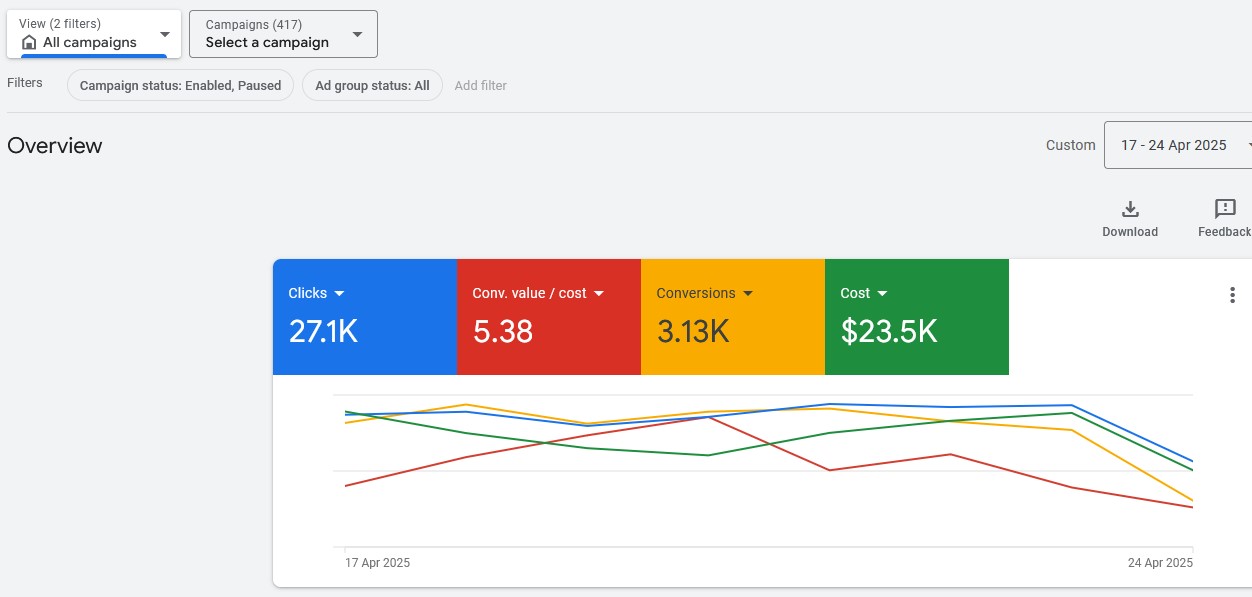
→ Action: Create a Google Ads account , set your billing, and build your first Search or Shopping campaign.
Google Analytics 4 (GA4) is a free tool from Google that helps you track and understand how people interact with your website or app. In GA4, everything people do — like clicking a button, viewing a product, or making a purchase — is called an "event."
GA4 automatically tracks some basic events for you, but you can also set up specific important events (like "Purchase," "Add to Cart," or "Item Viewed") to get more detailed insights. These events show up in your reports and help you see what’s working well on your site and where you might need to improve.
Think of GA4 as a way to watch the full journey of your customers — from the first time they visit to when they make a purchase — so you can make smarter business decisions.
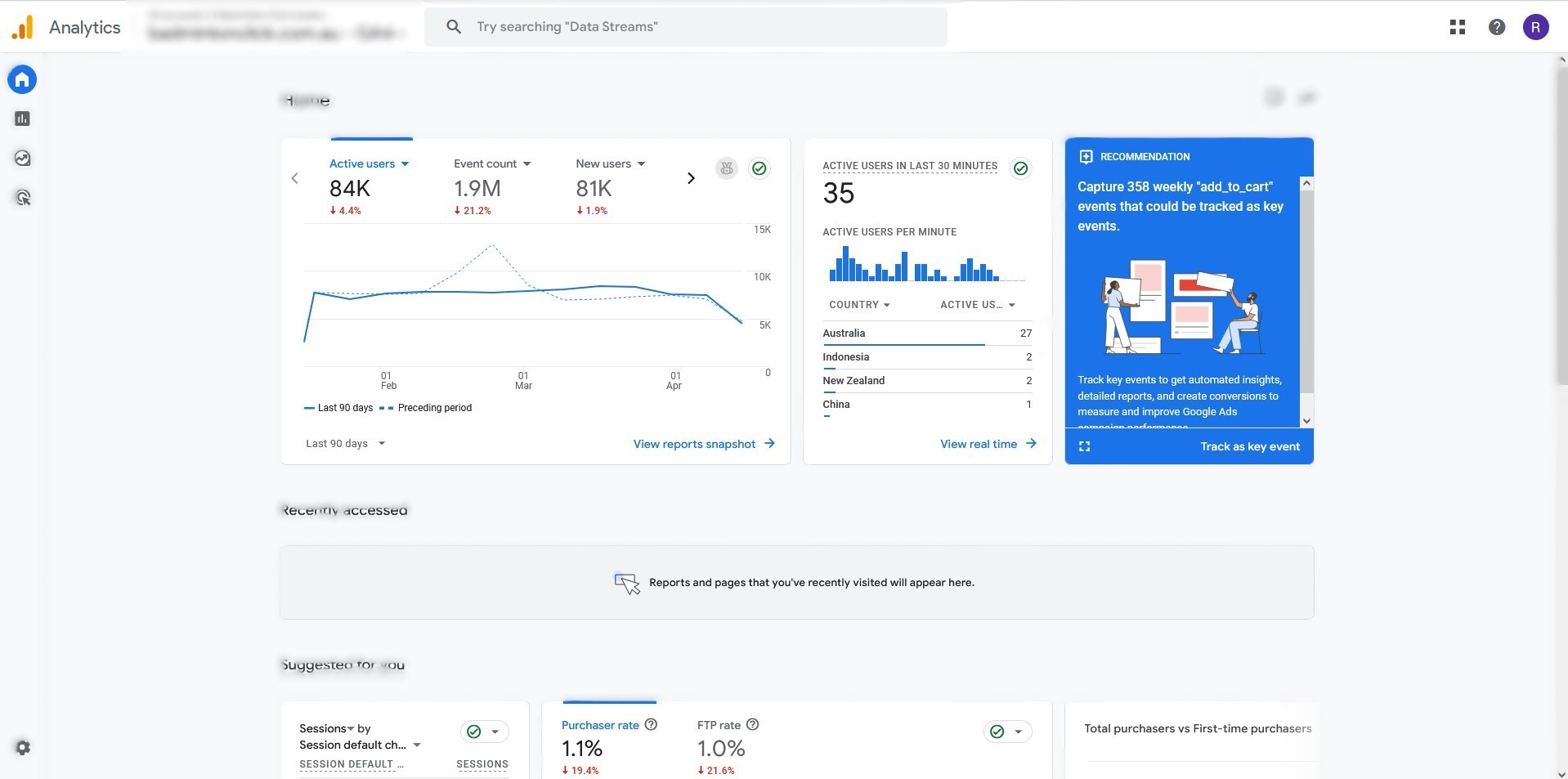
→ Action: Create a Google Analytics account , set up a GA4 property, and connect it to your website via Google Tag Manager.
Google Tag Manager (GTM) is a free tool that helps you manage all your website and app tracking codes (called "tags") from one place — without needing to touch your site's code every time you want to add or update something. You only need to ask your developer to install GTM on your Shopify store (or website) once. After that, you can add, edit, and control all your tags — like for Google Ads, Facebook Ads, TikTok Ads, and more — directly through GTM without needing a developer's help again.

→ Action: Sign up for a Google Tag Manager account, create a container, and add the GTM code to your website.
Lets your business appear on Google Search and Maps with contact info, reviews, photos, and updates—crucial for local visibility and trust.
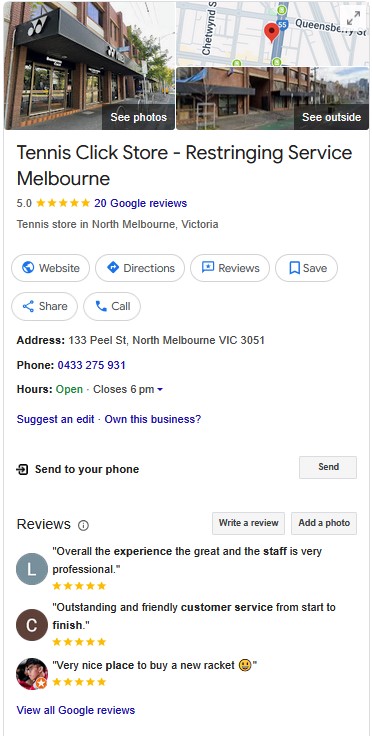
→ Action: Create or claim your Google Business Profile and verify ownership. Fill in accurate business details and upload professional photos.
Uploads and manages your product listings so they appear in Google Shopping ads and free listings. Required for eCommerce campaigns.
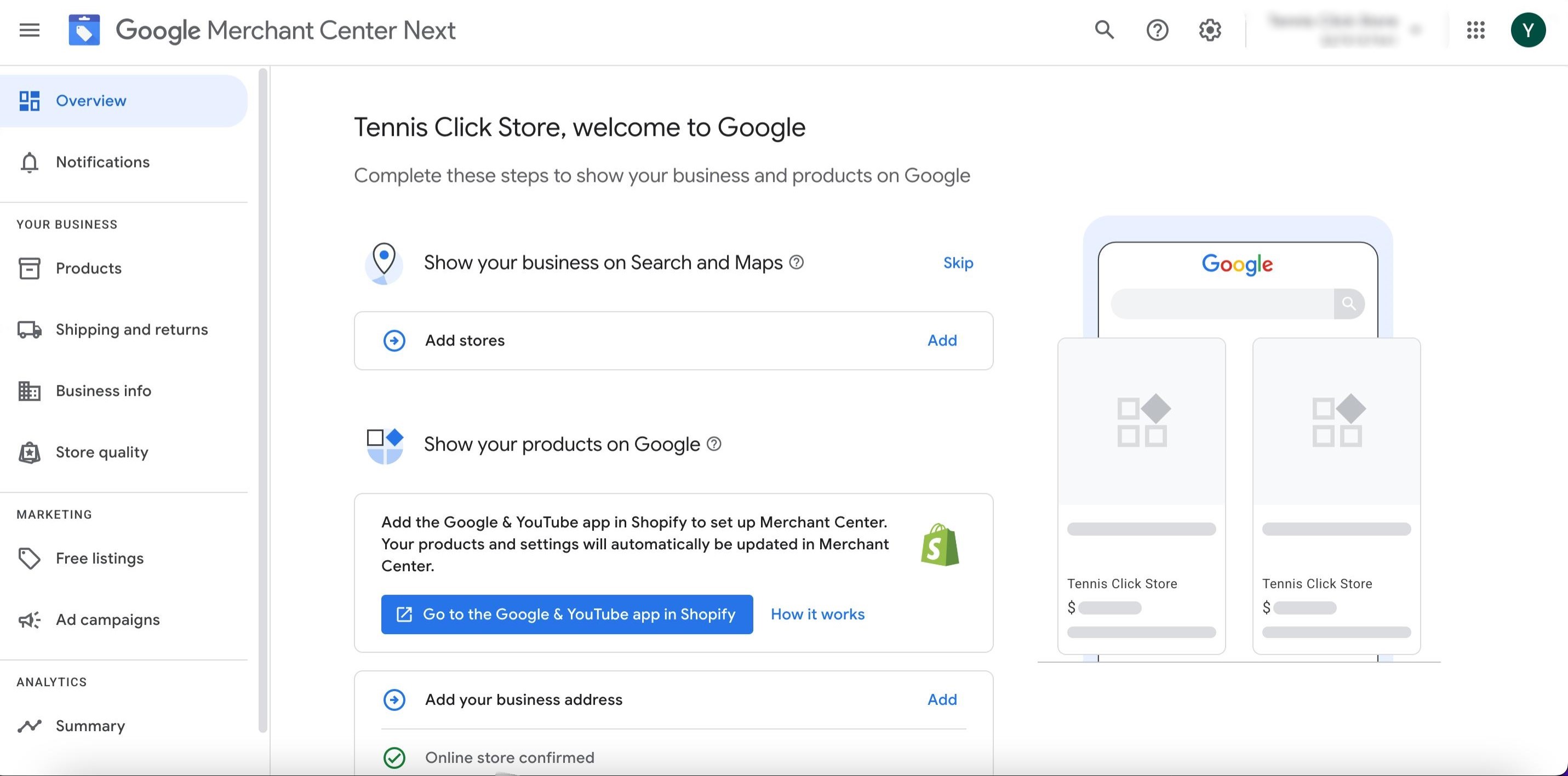
→ Action: Create a Google Merchant Center account, verify your website, and link it to your product feed.
Feeds structured product data (name, price, availability, etc.) from your website into Merchant Center to power Shopping ads.

→ Action: Create a product feed (via Shopify, WooCommerce plugin, or feed tool), then link it to your Merchant Center account via scheduled fetch or API.
Monitors and optimises your website’s performance in organic search. Helps detect technical issues, submit sitemaps, and improve SEO.
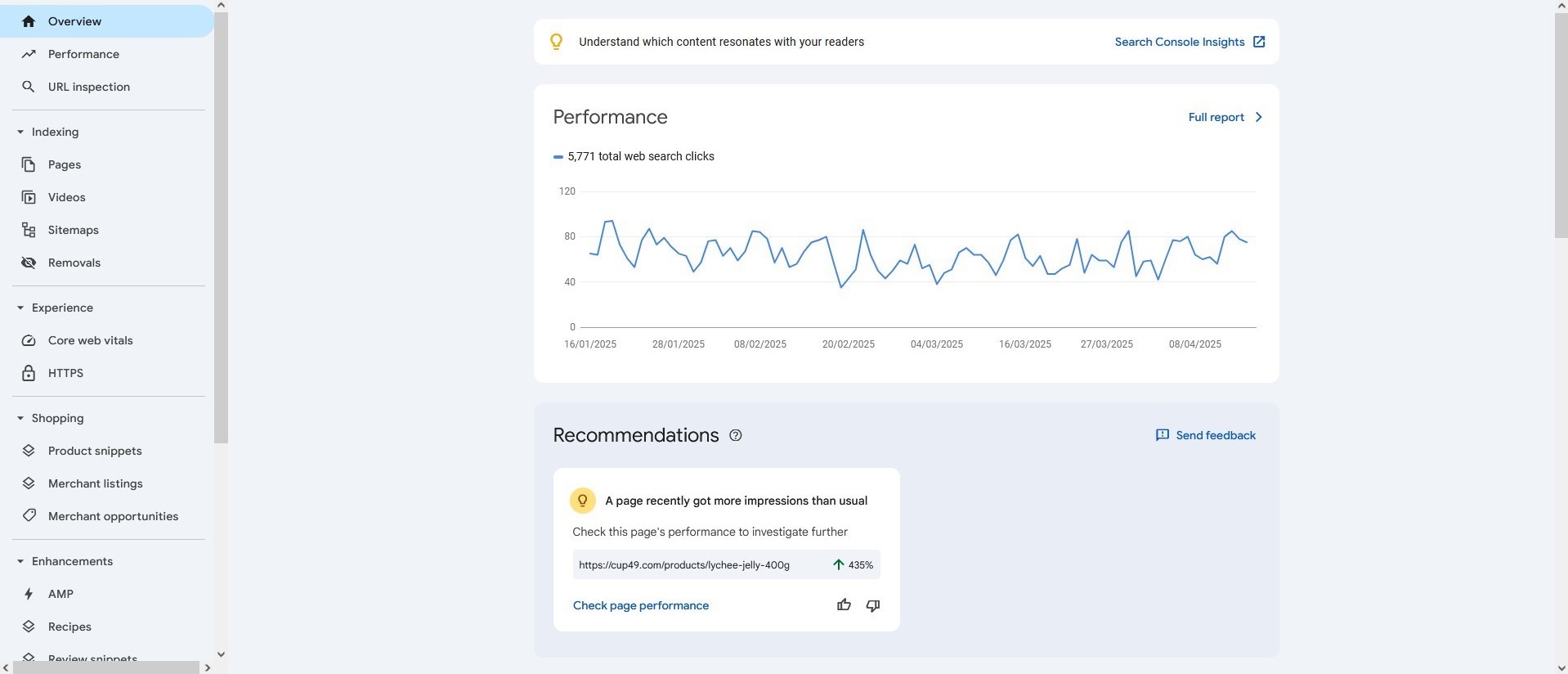
→ Action: Set up a Google Search Console account, verify your domain, and submit your XML sitemap.
Host and manage video content, run video ads, and build your brand’s presence on the second-largest search engine.

→ Action: Create a branded YouTube Channel linked to your Google account.
A reviews tool that collects photo reviews from customers and displays them on your site to increase trust and sales.
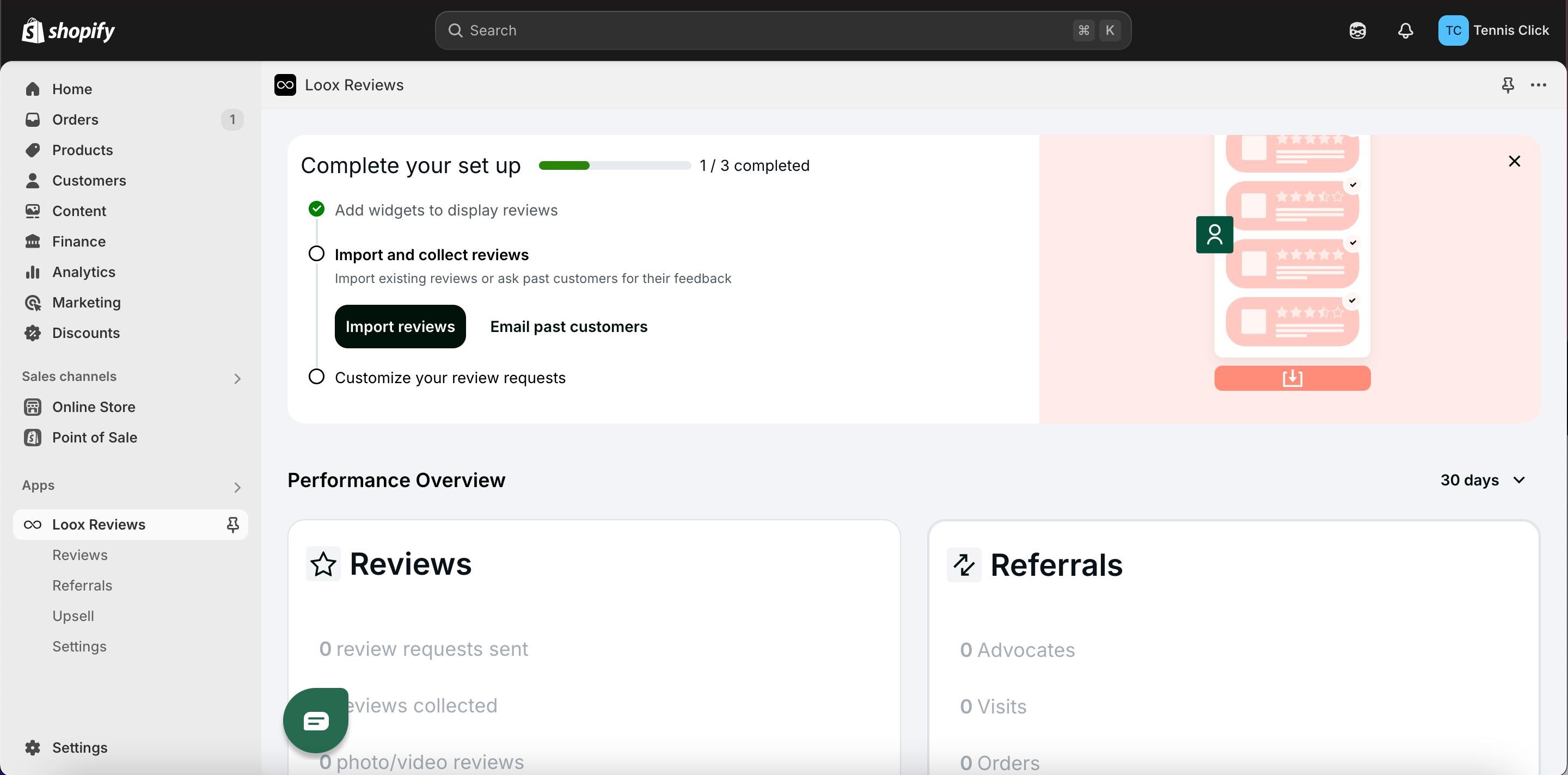
→ Action: Sign up for a Loox account , install the app on your store (e.g., Shopify), and customise your review request emails.
Klaviyo is an email and SMS marketing platform designed for eCommerce businesses. It enables you to create automated flows (like welcome series, cart abandonment emails, and win-back campaigns) and segment your audience based on behaviour for highly targeted communication.

→ Action: Create a Klaviyo account , integrate it with your eCommerce platform (e.g. Shopify), and set up your first automated email flow (e.g., abandoned cart recovery).

Conversion Tracking
Guideline
Implementation
Impact
GTM is a tag management tool that allows you to add, update, and manage tracking codes (tags) on your website without touching the backend code. It’s essential for setting up and controlling all other conversion events.
→ Action: Create tags and triggers in GTM for key events (e.g., form submissions, purchases), and test them in Preview mode before publishing.
GA4 offers an event-based tracking model that gives deeper insights into how users interact with your website. You can define and label important events (like purchases or sign-ups) as conversions.
→ Action: Go to the Events section in GA4, mark key actions like “purchase” and “form_submit” as conversions.
This tracks when users submit a form or sign up for something like a newsletter, consultation, or trial—valuable for lead generation.
→ Action: Use GTM to create a trigger that fires on form submission (e.g., by targeting form ID or URL), and send the data to GA4 and Google Ads as a conversion.
Tracks when a customer completes a transaction. Essential for calculating revenue, return on ad spend (ROAS), and optimising ad campaigns for actual sales.
→ Action: Set up a purchase event in GA4 (or eCommerce tracking using GTM or your CMS), and fire the tag on the thank-you or order confirmation page.
Measures how many users click your phone number link, which is especially useful for mobile traffic and service-based businesses that rely on phone inquiries.
→ Action: In GTM, create a trigger for clicks on tel: links and send an event to GA4 named something like "click_to_call".
Allows users to call your business directly from your Google Ads. Tracking call extensions gives insight into how often your ads lead to direct calls.
→ Action: In your Google Ads account, enable call reporting in your call extension settings and use Google Forwarding Numbers to track call performance and conversions.

Settings
Guideline
Implementation
Impact
Essential for establishing your store's identity and building customer trust.

→ Action: Navigate to Business info in Merchant Center, enter your business name, address, and phone number, then verify the phone number.
Confirms your ownership of the website connected to your Merchant Center account.

→ Action: Verify and claim your website using one of Google's approved methods (e.g. HTML file upload or meta tag).
Outlines shipping methods, delivery times, and costs, which is important for customer transparency.

→ Action: Add your shipping policy in Merchant Center under Shipping and returns > Shipping.
Clarifies how customers can return products, which builds trust and meets Google's listing requirements.

→ Action: Enter your return policy details in Shipping and returns > Returns in Merchant Center.

Product Feed
Guideline
Implementation
Impact
Connects your product data feed to Merchant Center for listing and ad purposes.

→ Action: Go to Data sources and add a new source (e.g. Google Sheets, scheduled fetch, or content API).
Helps match your products with relevant search queries on Google.

→ Action: Use descriptive and relevant titles (max 150 characters), placing key information first.
Provides users with key details about the product, influencing buying decisions.

→ Action: Write clear and concise descriptions that highlight benefits and features.
Attributes like price, brand, availability, and GTINs help define and categorise your products.

→ Action: Ensure all required and recommended attributes are completed in your feed for best performance.

Sub-Channels
Guideline
Implementation
Impact
Lets your products appear for free across Google surfaces like Shopping and Search.

→ Action: Enable Free Listings in the Merchant Center under Marketing.
Paid placements that showcase your products to users searching on Google.

→ Action: Link your Google Ads account and create a Shopping campaign.
Shows personalised product ads to users who previously interacted with your website.

→ Action: Enable Dynamic Remarketing under Add-ons in Merchant Center and tag your website correctly.
For Every New Performance Max Campaign
Guideline
Implementation
Impact
Headlines should be as close as possible to the 30-character limit to capture attention and maximise screen space.
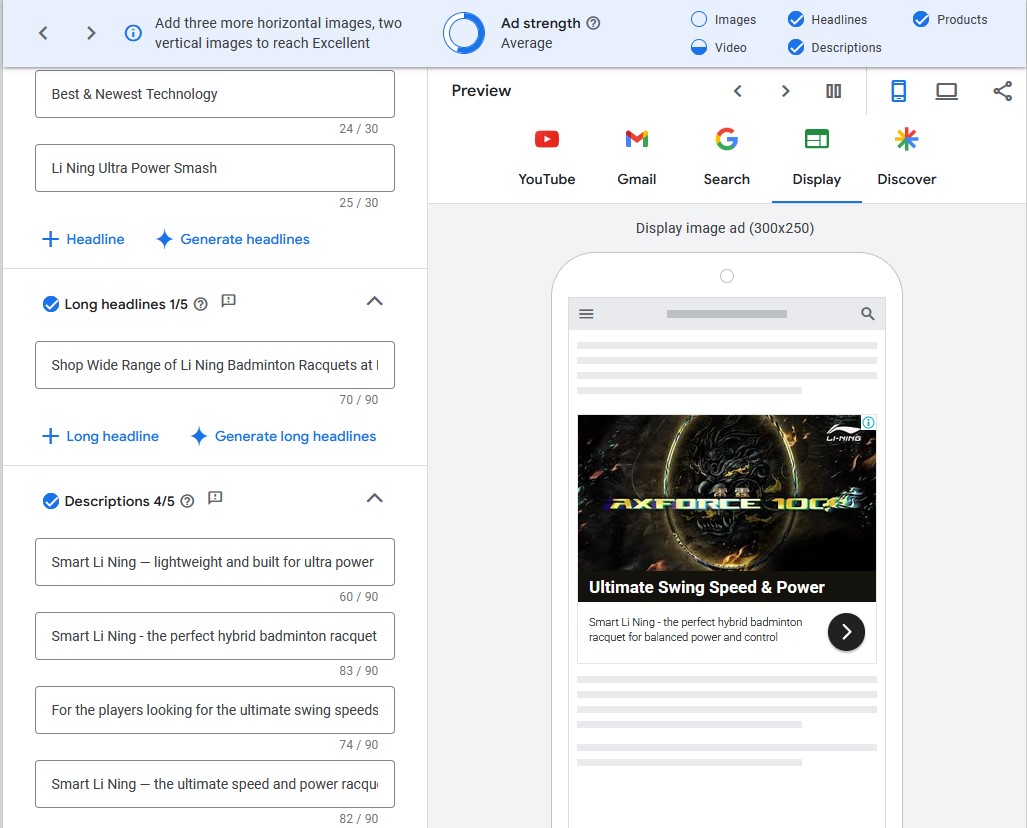
→ Action: Write multiple variations of headlines using the full character limit to improve ad visibility and engagement.
Longer descriptions (up to 90 characters) allow for better storytelling and persuasive messaging.

→ Action: Expand each description to the full character count, highlighting benefits, urgency, and unique selling points.
Your business name and logo create brand trust in visual ad placements. This helps potential customers easily recognize and connect with your brand.
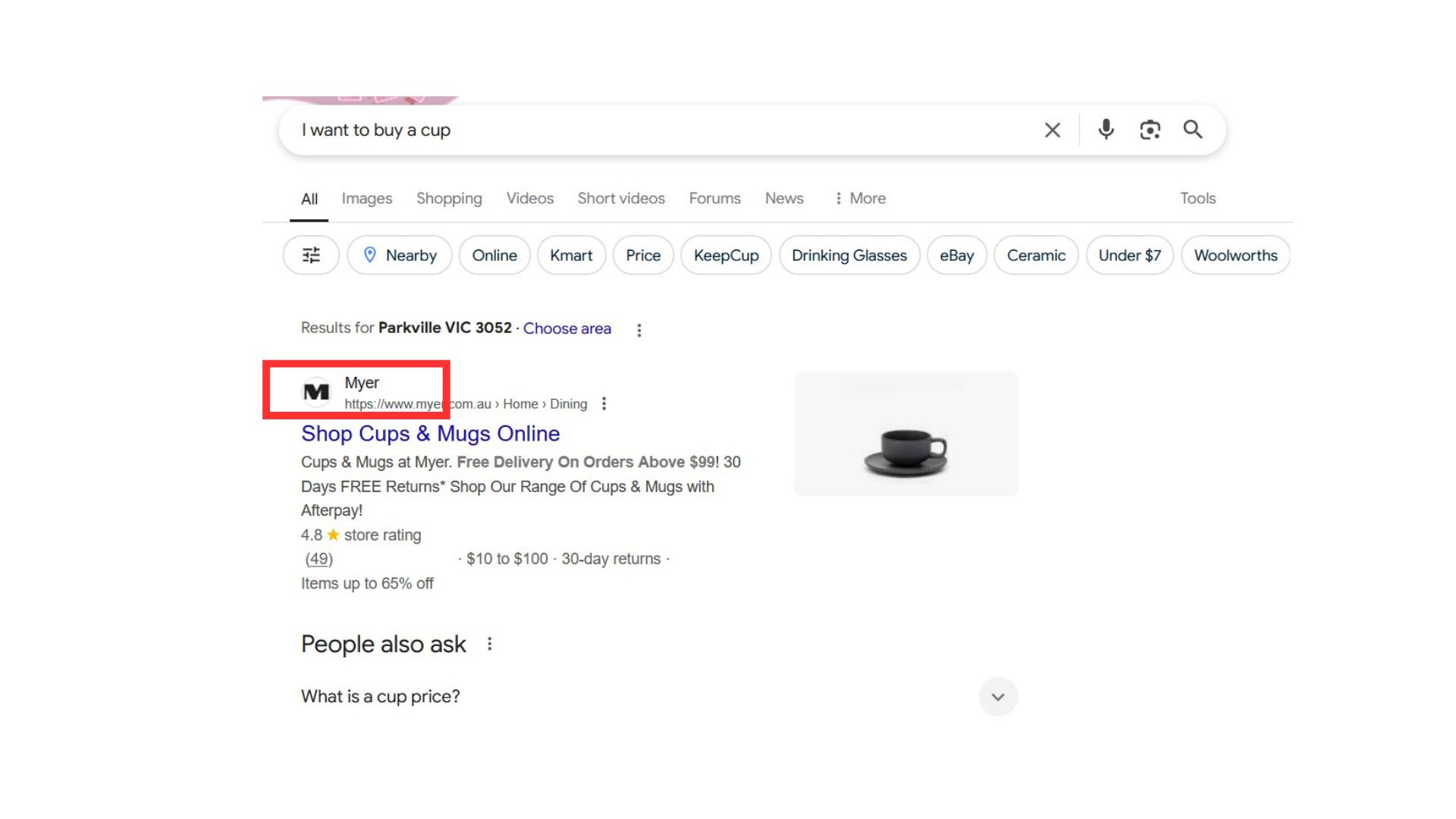
→ Action: Upload your official business name and a square (1:1) logo image in high resolution.
CTAs encourage users to take the desired next step. A missing or weak CTA can reduce click-through and conversions.
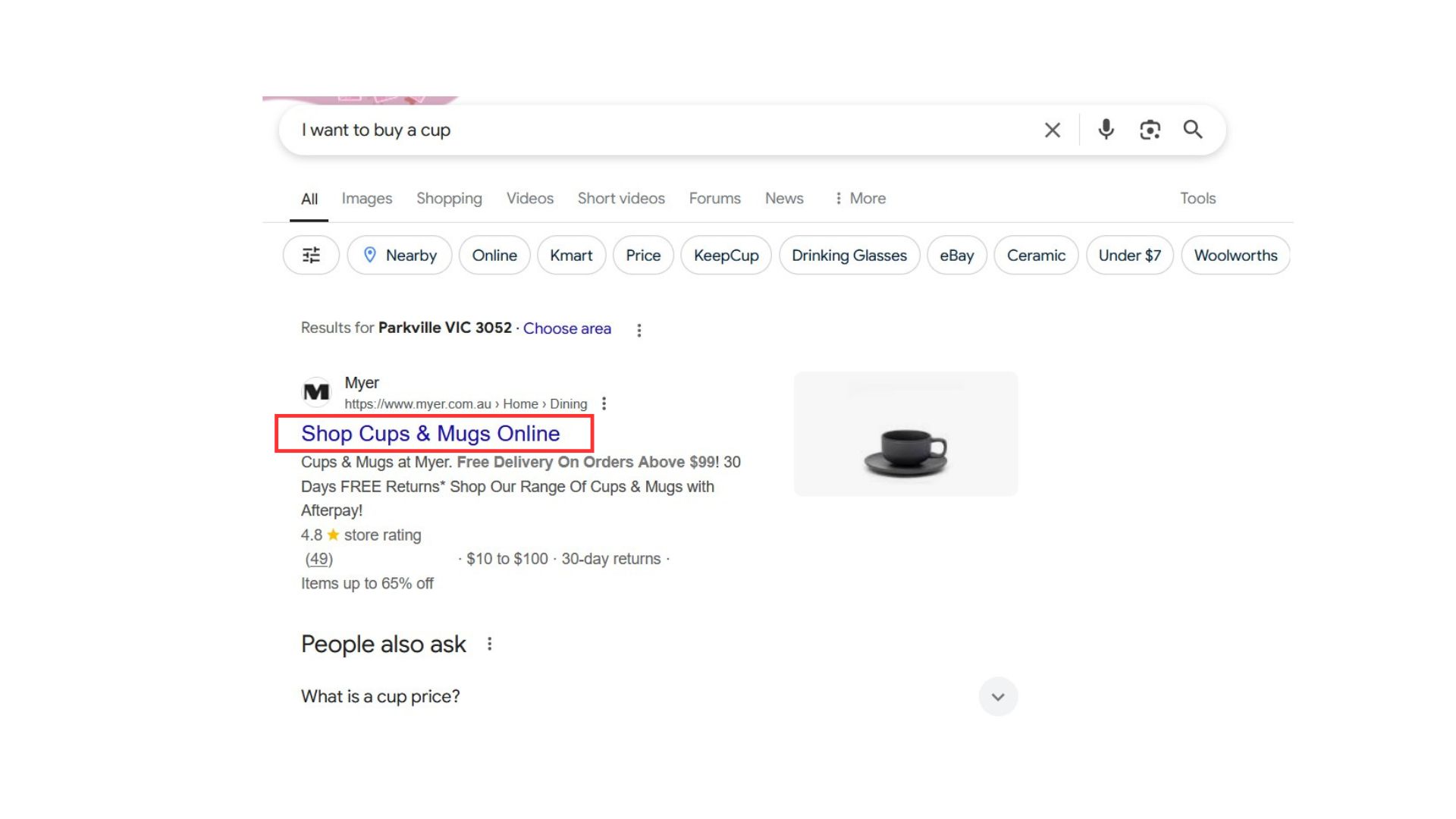
→ Action: Include strong CTAs like "Shop Now," "Get a Quote," or "Learn More" in your headlines or descriptions.
Google provides real-time feedback on ad quality. A "Good" or "Excellent" score increases chances of high ad delivery.
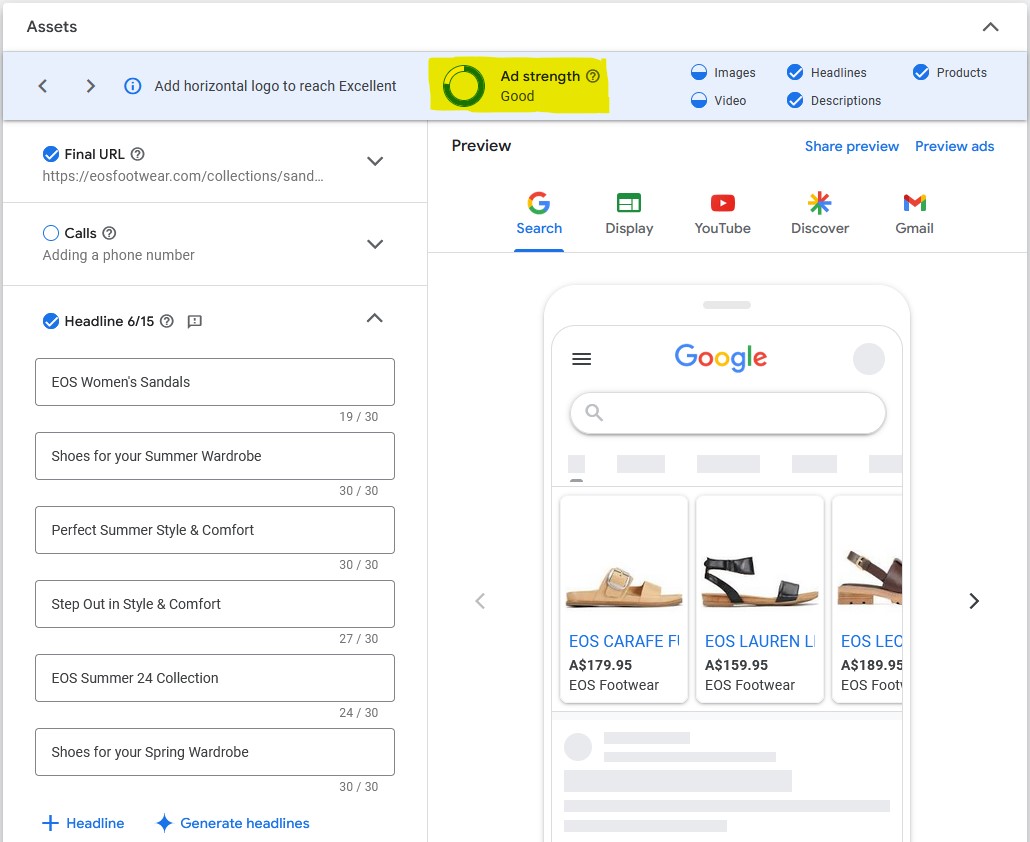
→ Action: Add diverse headlines, descriptions, and assets until Ad Strength reaches "Good" or higher.
Check that the URL linked is the designated URL link

Image Assets
Guideline
Implementation
Impact
Images are essential for Performance Max campaigns, as they help attract attention and improve visual appeal. High-quality images can significantly enhance click-through rates (CTR).

→ Action: Upload at least 5 high-resolution images in different aspect ratios (1.91:1, 1:1, 4:5, etc.) to ensure compatibility across various placements.
Landscape (1.91:1) images are ideal for display placements and banner ads.

→ Recommended size is 1200 x 628 px
Square (1:1) images work well across most placements including social media and product listings.

→ Recommended size is 1200 x 1200 px
Portrait (4:5) images are optimal for mobile placements and stories formats.

→ Recommended size is 960 x 1200 px
Landscape logo (4:1) is used for brand recognition in certain ad formats.

→ 1200 x 300 px recommended, minimum 512 x 128 px

Video Assets
Guideline
Implementation
Impact
Videos are an important asset in Performance Max campaigns, helping to extend your reach across YouTube and Display networks. Including videos can boost engagement and ad performance.

→ Action: Upload at least one short video (10–30 seconds) showcasing your product or service in action in multiple aspect ratios.
Standard widescreen format ideal for YouTube and desktop displays.

→ Horizontal (16:9) – e.g., 1920 x 1080 px
Mobile-optimized format perfect for stories and mobile feeds.

→ Vertical (9:16) – e.g., 1080 x 1920 px
Versatile format that works well across both desktop and mobile placements.

→ Square (1:1) – e.g., 1080 x 1080 px

Call Asset
Guideline
Implementation
Impact
Call assets allow users to contact your business directly from the ad, which is particularly beneficial for local or service-based businesses.
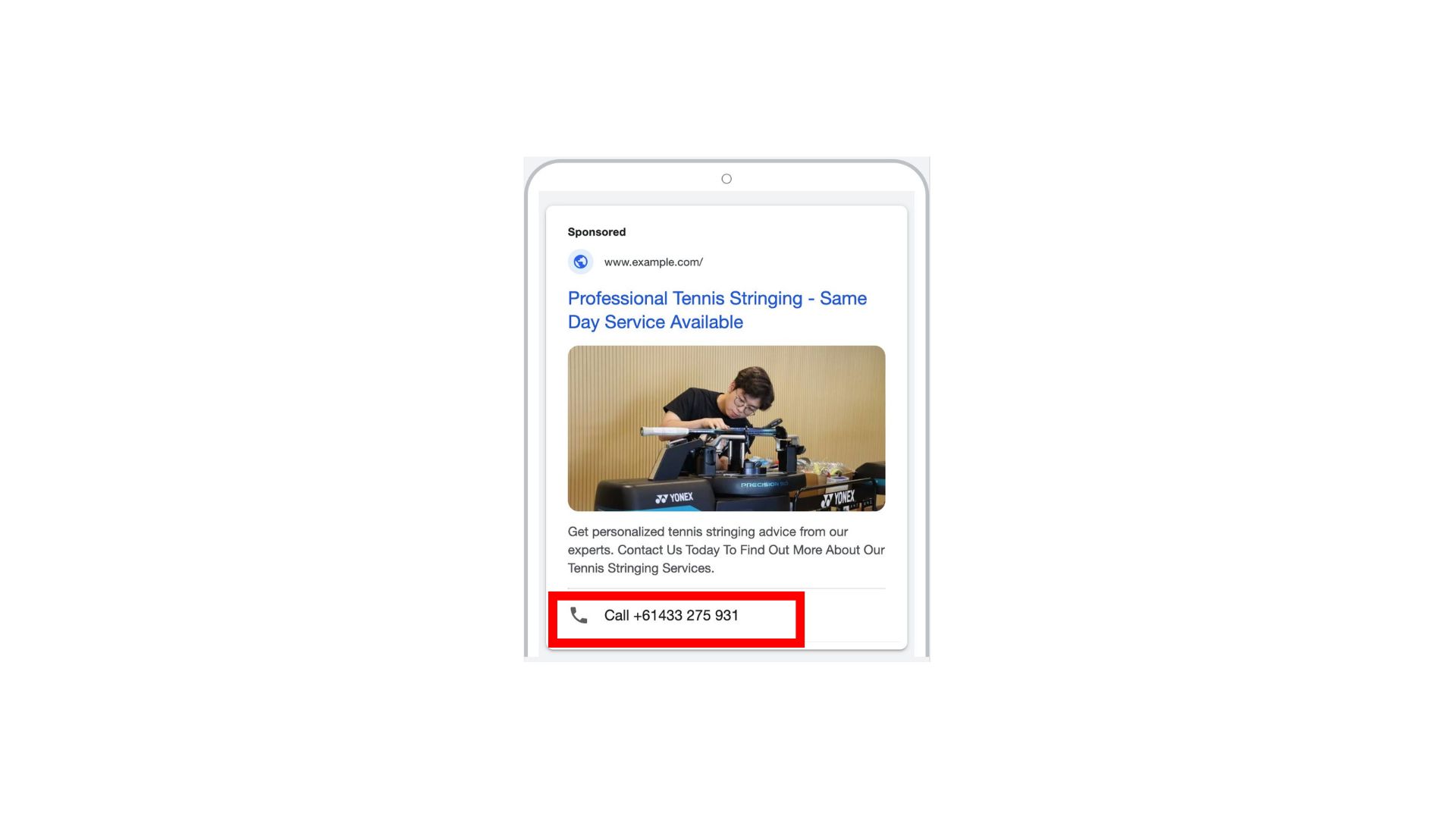
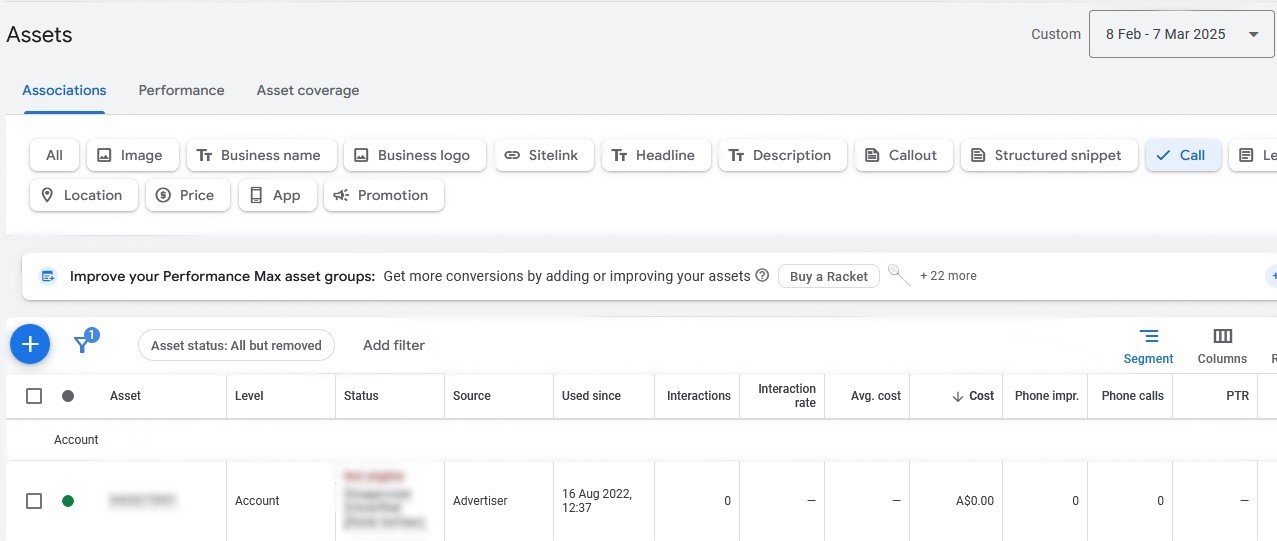
→ Action: Set up a call asset in Google Ads by adding your business phone number and enabling call reporting.

Location
Guideline
Implementation
Impact
Syncing your Google Business Profile (GBP) with Google Ads allows location-based ads to display, including maps, directions, and reviews, enhancing local visibility.
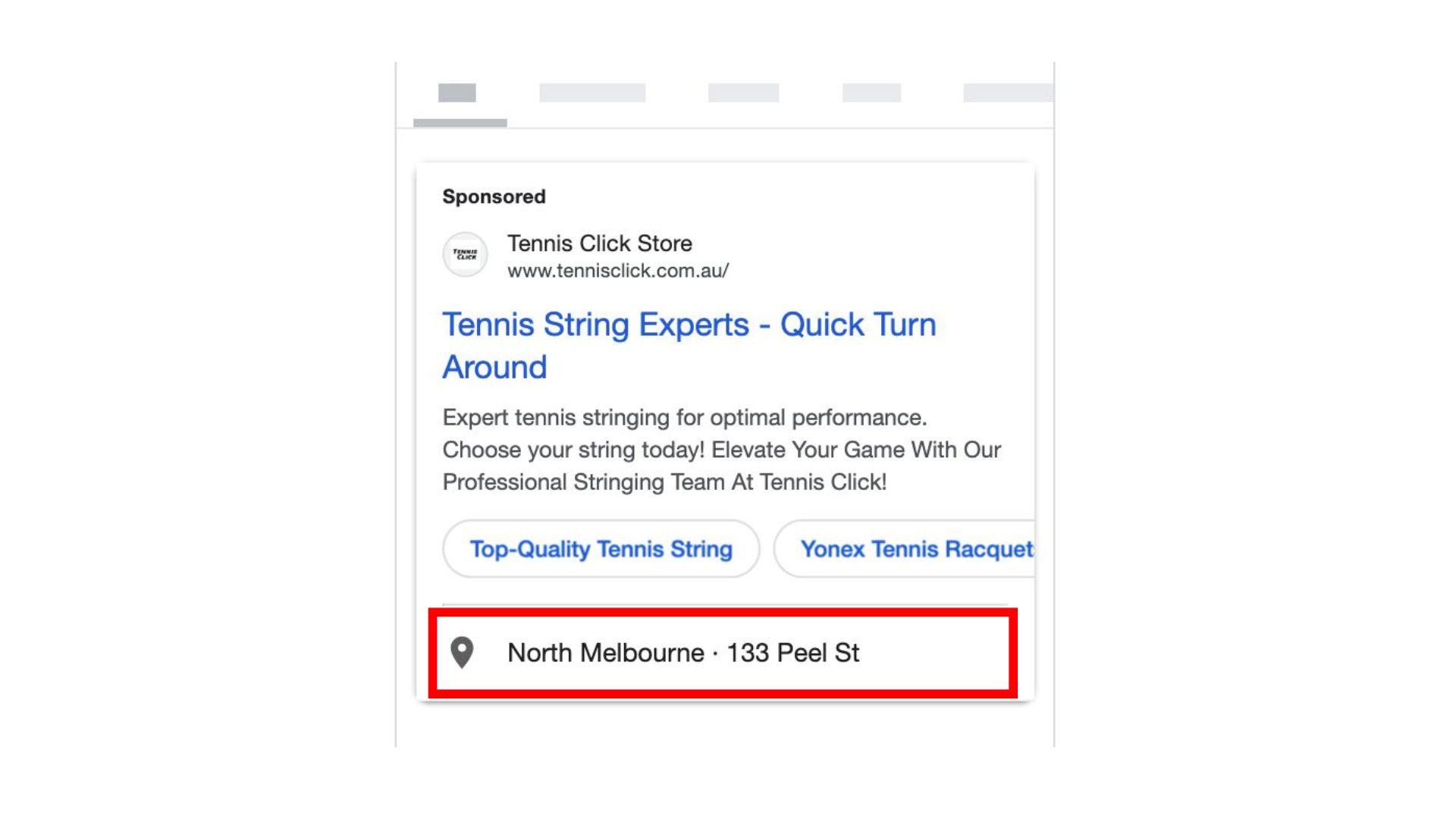
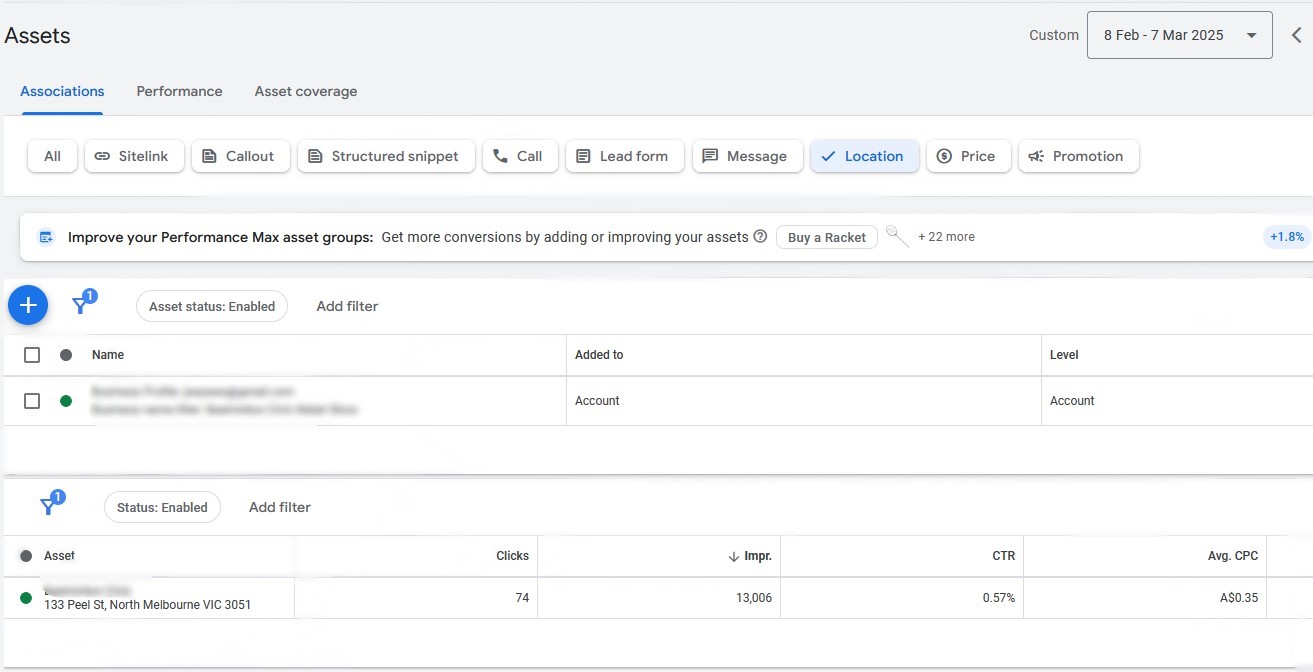
→ Action: Link your Google Business Profile to Google Ads in the linked accounts section.

Price Assets
Guideline
Implementation
Impact
Price assets display your product or service pricing directly in the ad, providing clear cost information that can increase CTR and help customers make decisions faster.
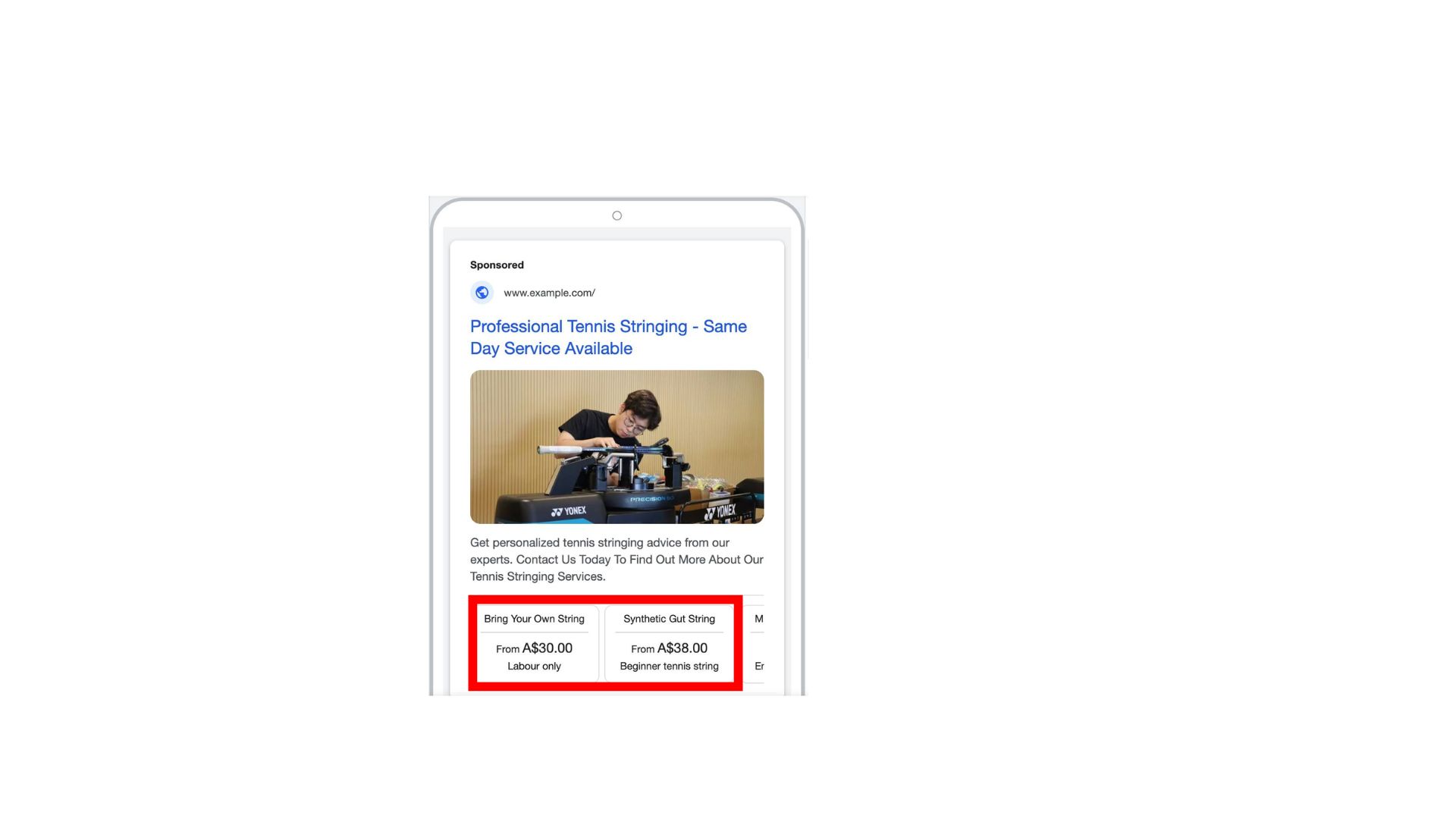

→ Action: Add price asset for key products or services and link them to your relevant landing pages.

Sitelinks
Guideline
Implementation
Impact
Sitelinks allow users to navigate directly to specific pages on your website, such as Products, About Us, or Contact, improving the user experience and CTR.

→ Action: Create at least 4 sitelinks with relevant URLs and descriptions to enhance your ad's functionality.

Callouts
Guideline
Implementation
Impact
Callouts are short, catchy text snippets (e.g., "Free Shipping" or "24/7 Support") that highlight additional value and encourage clicks.
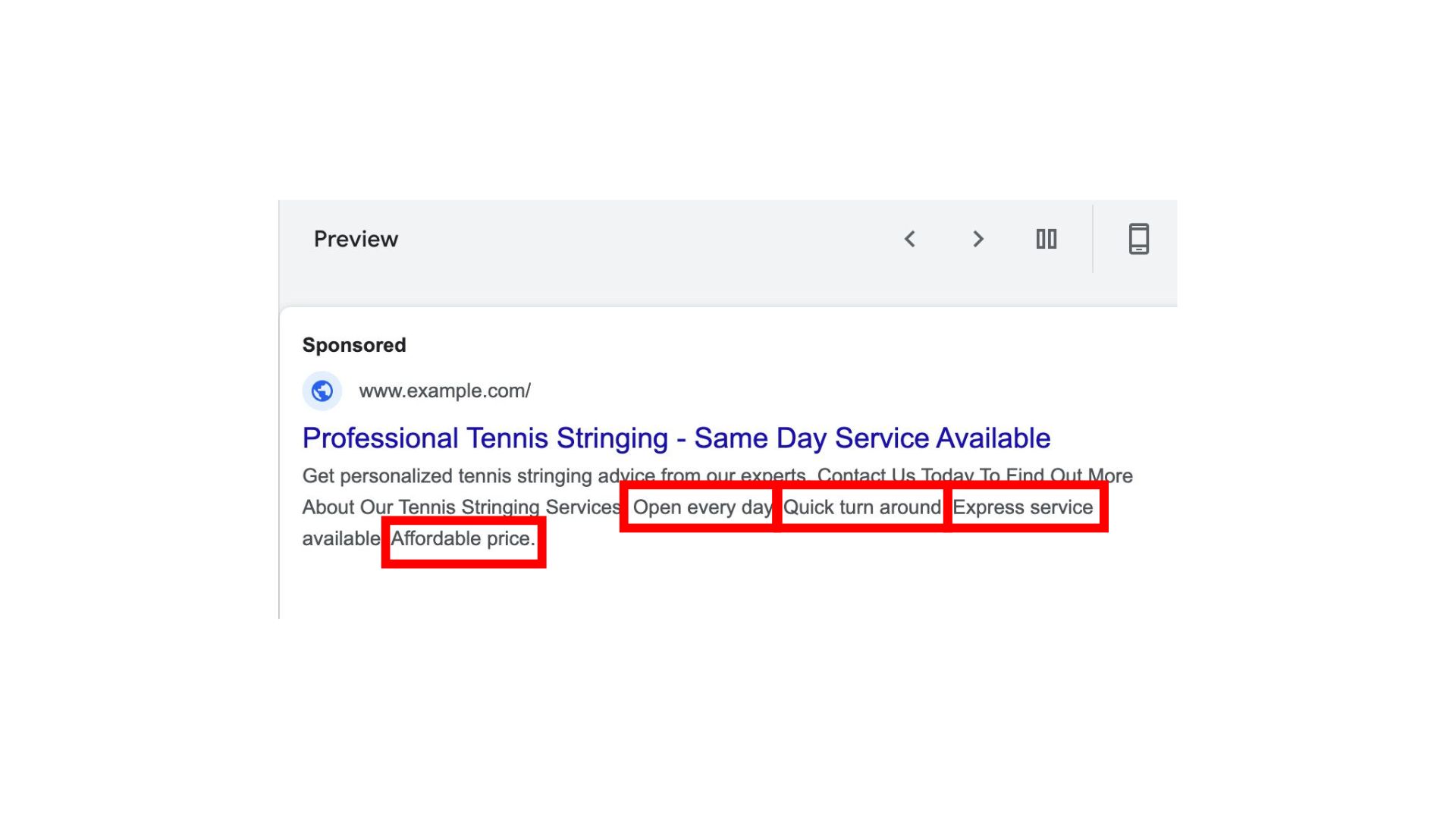
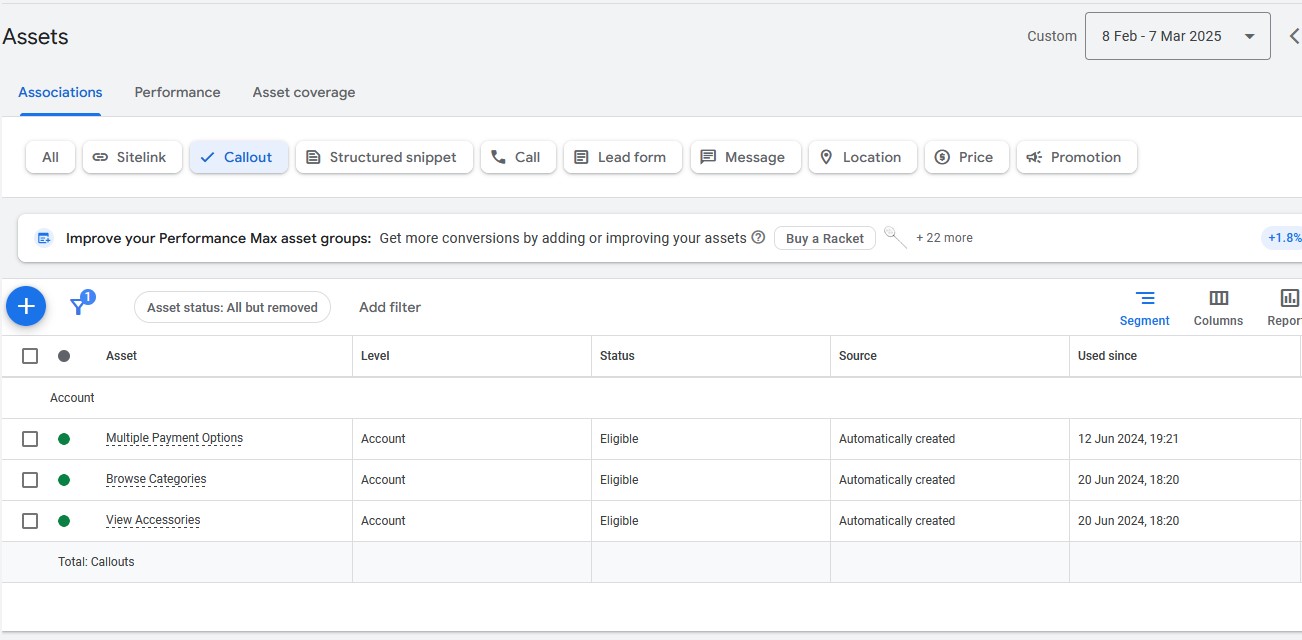
→ Action: Add at least 4 callout extensions to highlight your unique selling points and increase ad appeal.

Structured Snippets Assets
Guideline
Implementation
Impact
Structured snippets highlight specific aspects of your offerings, such as services or brands, in a format that is easy for users to understand at a glance.

→ Action: Add at least one structured snippet with relevant headers and values (e.g., "Services: Installation, Repairs, Maintenance").

Audience Signal
Guideline
Implementation
Impact
Remarketing lists allow you to re-engage users who have previously interacted with your website or app. Adding them to your Performance Max audience signal helps Google better understand your ideal customer and optimise targeting.

→ Action: Create and add a remarketing audience list in Google Ads under "Audience Manager."
Custom intent audiences let you reach people based on their recent search behaviours and interests relevant to your business. These audiences signal high purchase intent and are great for targeting niche segments.
→ Action: In Audience Manager, create a custom audience based on relevant search terms or URLs that your ideal customers are actively looking for.
Customer Match uses your first-party data (like email addresses or phone numbers) to target existing customers or leads across Google platforms. It's useful for upselling, loyalty campaigns, or re-engaging lapsed customers.
→ Action: Upload a CSV file of your customer data to Google Ads and create a Customer Match audience under "Audience Manager." You can download the template from the link provided.
Similar segments previously helped you find new users who behave similarly to your existing audience. However, Google is phasing them out in favour of automated audience expansion in Performance Max and Smart campaigns.
→ Action: Focus on using robust first-party audiences (like Customer Match and remarketing) as primary signals, and rely on Google's automated systems to expand reach.

Campaign Settings
Guideline
Implementation
Impact
Your bid strategy determines how Google spends your budget to achieve your goals (e.g., conversions, ROAS).

Action: Choose a bid strategy that aligns with your objective (e.g., Maximise Conversions, Target ROAS) and review performance regularly to adjust if needed.
The daily budget controls how much is spent per day. Underspending can limit reach, while overspending may reduce efficiency.

Action: Set a realistic daily budget based on your campaign goals and average cost per acquisition (CPA). Adjust as performance trends evolve.
Audience targeting ensures your ads reach the most relevant users.


Action: Add custom segments, remarketing lists, and customer data to guide machine learning and improve targeting precision.
Location settings determine where your ads are shown. Misaligned targeting can waste budget.


Action: Target only regions relevant to your business and exclude areas with poor performance or no service coverage.
Your ad schedule dictates when your ads are eligible to show. Running ads 24/7 isn't always efficient.

Action: Set ad schedules based on historical performance data to run ads only during high-converting times.
Recurring Check

Asset Groups
Guideline
Implementation
Impact
Ensure your call extensions are still active and accurately reflect your business phone number.

Action: Review and update call extensions regularly within the ad group settings.
Outdated or underperforming images can affect CTR.

Action: Replace low-performing images with new, high-quality creatives every 30–60 days.
Logos are crucial for brand recognition in visual ads.

Action: Confirm your logo is current and clearly visible across formats.
Headlines impact ad relevance and CTR.

Action: Refresh or rotate headlines based on asset performance reports.
Long headlines are used in certain placements and must be compelling.

Action: Review long headline performance and revise if engagement is low.
Descriptions provide context and can drive clicks.

Action: Test new descriptions and replace any that underperform.
Your business name needs to be correct and consistent across assets.

Action: Cross-check business name in assets and update if needed.
Sitelinks improve ad navigation and performance.

Action: Make sure sitelinks are working and still relevant.
A clear call-to-action can increase conversions.

Action: Use performance data to test and update your CTAs.

Audience Signals
Guideline
Implementation
Impact
Audience accuracy affects targeting efficiency.

→ Action: Update custom segments based on evolving customer insights.
Targeting the right interests ensures ads reach high-intent users.

→ Action: Analyse and refine audience interests/demographics regularly.
Customer match lists must be updated to stay relevant.
→ Action: Upload new customer data monthly or after major campaigns.

Preview Ad Content
Guideline
Implementation
Impact
Ad previews show how users see your ad across placements.


→ Action: Regularly preview ads to ensure no broken assets or layout issues.

Review ROAS
Guideline
Implementation
Impact
Different product groups perform differently.

→ Action: Optimise bids and budgets based on ROAS per listing group.
Identifying top-performing products helps budget allocation.

→ Action: Adjust product feed and focus spend on high-ROAS items.

Locations
Guideline
Implementation
Impact
Location targeting influences local visibility and relevance.

→ Action: Verify active target locations align with business goals.

Bidding Strategy
Guideline
Implementation
Impact
Your bid strategy affects spend efficiency.

→ Action: Review performance metrics and adjust bidding (e.g., Maximise conversions vs. Target ROAS) based on objectives.

Merchant Centre Check In
Guideline
Implementation
Impact
Merchant Centre errors can impact ad delivery.

→ Action: Log into Merchant Centre weekly to resolve feed or policy issues.

Optimisation Score
Guideline
Implementation
Impact
Google's optimisation score gives actionable recommendations.

→ Action: Perform monthly audits to ensure score remains above 80%.

Key Insights
Guideline
Implementation
Impact
Insights reveal what's working and what's not.

Action: Use Google Ads insights to identify trends and adjust strategies.
Understand competitor performance in your auctions.

Action: Monitor auction insights to refine bids and audience strategies.
See when and where your ads appeared for transparency and refinement.


Action: Use this data to adjust ad scheduling and location targeting.

Campaign Performance (Trend)
Guideline
Implementation
Impact
Cost trends help manage budget and identify waste.

Action: Compare weekly/monthly spend to performance goals.
Conversions drive ROI.

Action: Watch for drops or increases in conversions and investigate causes.
Cost per conversion helps measure acquisition efficiency.

Action: Optimise targeting and bidding if CPL rises above target.
Click-through rate indicates ad engagement.

Action: Improve CTR with better headlines, CTAs, and visuals.
Low conversion rates may signal landing page or audience mismatches.

Action: Audit funnel from ad click to conversion and optimise steps.

Ad Group Performance (Trend)
Guideline
Implementation
Impact
Spending should align with return per ad group.

→ Action: Pause or optimise underperforming groups.
Conversion rates show which ad groups deliver results.

→ Action: Shift budget towards high-converting groups.
Know how much each ad group costs per lead.

→ Action: Adjust strategy if costs climb too high.
Healthy CTR reflects relevant and appealing messaging.

→ Action: Refresh creatives in low-CTR groups.
Conversion rate reflects post-click experience.

→ Action: Optimise landing pages and refine targeting where needed.

We’re based in
Melbourne, Australia